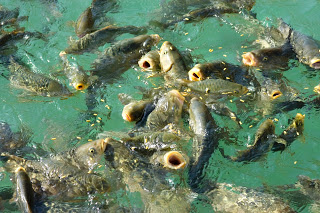For starters, why is wild better than farmed fish?
- Wild fish, as the name implies, have room to swim. Farmed fish, on the other hand, are often confined to crowded spaces. One consequence of this is that farmed fish is fattier. Unfortunately this increase in fat isn’t the “good” fat. Wild salmon is 20% higher in protein and 20% lower in far than farm raised.
- Farmed fish is lower in omega 3’s than wild fish
- Fish farming is similar in many ways to factory farms for animals. Crowded conditions lead to contamination and the need for antibiotic use. Sulfa drugs with your salmon anyone?
- Farmed fish aren’t searching for their next meal, they are “fed”. Their diet is very different from their wild counterparts. I had no idea farmed fish weren’t fed fish or other marine “stuff” until I read an article in the NYT last spring about tilapia farms. Corn, soy, wheat and even chicken (yes chicken) are used at fish farms.
- Due to the change from natural feed, farmed fish looks different than wild. Two red food dyes are used to color the flesh of farmed salmon. Otherwise it would appear greyish. This dying is known as “color finishing”. One of these colors is made from a strain of red yeast.
- Furthermore the proximity of many fish farms to wild fish adversely affects wild fish. A parasite known as sea lice has been on the rise due to this.
Antibiotics, corn and chicken in my fish? No thank you, I choose wild whenever possible but have certain lingering questions:
How do you know if fish is farmed or wild?
My general rule is that stores and companies using or selling wild fish want you to know and this fish is generally labeled. If it doesn’t say wild, it is almost always farmed. “Bred”, “raised” and “cultivated” are euphemisms for farmed. Atlantic salmon is farmed.
Are all farms flawed?
As I scoured Monterey Bay Aquarium’s Seafood Watch site, I learned that fish farming or aquaculture is part of our future. “The ecological impact of fish farming depends on the species chosen, where the farm is located, and how they are raised.” Not all fish farms are polluting the oceans and not all farms use chicken feathers as feed. The problem is that you can’t very well ask the waiter at the restaurant if your fish came from a good farm or a nasty one. I would hope at some point there will be language much like “grass fed beef” to inform consumers.
Until the time when we can distinguish better farms from foul (or fowl) ones. Wild is the better bet. Canned wild salmon and wild sardines are more affordable options. And though farmed fish has its drawbacks and is inferior to wild nutritionally, I wouldn’t go ordering the steak.
Do you find fish facts confusing? Do you pay attention to where your fish comes from? Does coloring, antibiotics, soy or wheat used with farmed fish worry you?



I definitely try to choose wild-caught over farmed-raised, but sometimes it's just not in my budget, and I'd rather just eat the fish than not at all. I hate to admit it but I think the farm-raised normally tastes better, and I don't even WANT to know what they add to it to make it taste better (ewww). But 90% of he time I buy the wild.
I do mandoline (regarding your question) and I love it. Nick bought me one of the hand-held mandolines last ear for Christmas and it's very easy to use.
Agree, farmed if don't have the wild choice but I think asking questions about farms, improving farms will come from consumers (and RDs) raising the issue. OK will consider mandoline and face my fear!
Fish being fed corn or soy? Wow, that's eye-opening!
Yes, I definitely buy wild fish for all the reasons you mentioned above. And I agree, canned wild salmon is a more affordable option, and I frequently add it to my lunch salads.
Thanks for not scrapping this post. I did not know about the "color finishing" and the products used to feed the farmed fish. Gross.
-C Petroski
walking here with a smile. take care.. have a nice day ~ =D
Regards,
http://www.lonelyreload.com (A Growing Teenager Diary) ..
Thanks Catherine yes- coloring and corn in your fish, lovely.
Artificial food dye to color the flesh of farmed salmon??!! Makes me nauseous… everyday I learn a new "trick" used to make food appear a certain way so that it's more appealing to consumers!! Sad…
The fish industry is in general very worrisome. I try to buy fish that is sustainably fished, since some fishing practices wreak absolute havoc on the ecosystems.
I have learned to spend the money on good food. Of course, I'm not feeding a large family. But now I'm in my mid 40s and it's a decision I've been blessed to make. Specifically, if I can't buy wild fish, I don't buy it.
Stephanie, that's precisely the topic that confuses me a little. Most farms do "wreak havoc" as you say. There are farms that are either removed from oceans/waterways or done in a "responsible" manner. Caron- impressive that you buy wild or don't buy at all. I would consult Seafood watch as there are some "farmed exceptions".
Lauren – what do you think about sushi? We eat lots of it and now I wonder if it is farmed fish that they are using.
Very good question. Monterey Bay has a handy seafood guide for sustainable sushi, here is the link http://www.montereybayaquarium.org/cr/cr_seafoodwatch/sfw_sushi.aspx
Thank you for this very well-written post! Love the puns…
I feel like the more I know the less I know. I go through phases; I learn about something that is horrible (BPAs, farmed fish, chicken farm icky-ness) and then a few weeks, months, years pass and it's like amnesia sets in. I am like, why did I stop eating that again? I just bought a big thing of frozen tilapia, and now you've reminded me why I stopped buying tilapia at KeyFood! ARGH!
PS. Did you ever see this?
http://youtu.be/l2LBICPEK6w – very funny and apropos to your last comment about "asking the waiter", enjoy!
I agree that it can be confusing when looking at the farmed vs wild info. It appears that some fish (ie: Alaskan salmon) that are better wild but then there are some breeds where is it more sustainable to buy the farmed version…very well written post!
That is gross!!! Artifically colored fish breed on chicken feathers! I do however eat only wild fish. Have to thank my mom for that one. She will only buy wild fish because she swears it tastes so much better. I was recently in the south of france (yes, life is hard!) and was at a restaurant where you literally watched them catch the fish and they cooked the sole in front of you. Some salt, pepper and lemon and heaven!
On a side note….I noticed in France that the fruits and vegetables were so much tastier. I walked around eating tomatoes like apples from the market. Even at the farmer's markets and whole foods here I have not seen produce like that. Any idea why?
Thanks Caitln, yes there are sustainable farms. From a nutrition standpoint we don't know the nutrition of the "better" farmed fish versus the lousy ones.
Thanks for shedding a little light on this issue Lauren, because I agree, it is SO confusing! I do buy wild whenever possible, but then worry about overfishing implications. I do use the Monterrey Bay Seafood Watch list , and find it to be helpful. Maybe next post you can tackle the whole other issue of GMO Aqua Bounty Salmon-that's a whole other can of worms,er, I mean salmon!
This is definitely a confusing topic, and tough to make appropriate recommendations for clients. I only buy wild fish and have stopped buying tilapia altogether because of what I've learned about tilapia farming. When David Grotto visited a salmon farm in Vancouver (I think), I asked him about the coloring and he said they use a vitamin supplement, not artificial coloring.
This is such a confusing topic to me. We aren't eating much fish right now as a result of wild fish being so expensive in our area. Also, did you find anything in your research about wild fish and pollution or radiation from Japan? I've heard it mentioned as a possible issue.
Laura, I didn't look at the impact of radiation because frankly, there are so many things polluting our waters. I hate to think of people avoiding fish because, if it's the right fish, there are few healthier things to consume.
If you have anymore questions, or comments, please feel free to visit our website! http://www.bcsalmonfacts.ca
BC Salmon, clearly you are in the "industry" and I am not and therefore gather information from a variety of sources versus picking out the information that skews for my benefit. I love comments if comments are helpful and an appropriate length. I left your url up in case anyone wants to check it out but in the future please keep comments brief and if you have a similar post or article I'd be happy to link to it.
We love to fish…so we eat wild fish mostly. 🙂